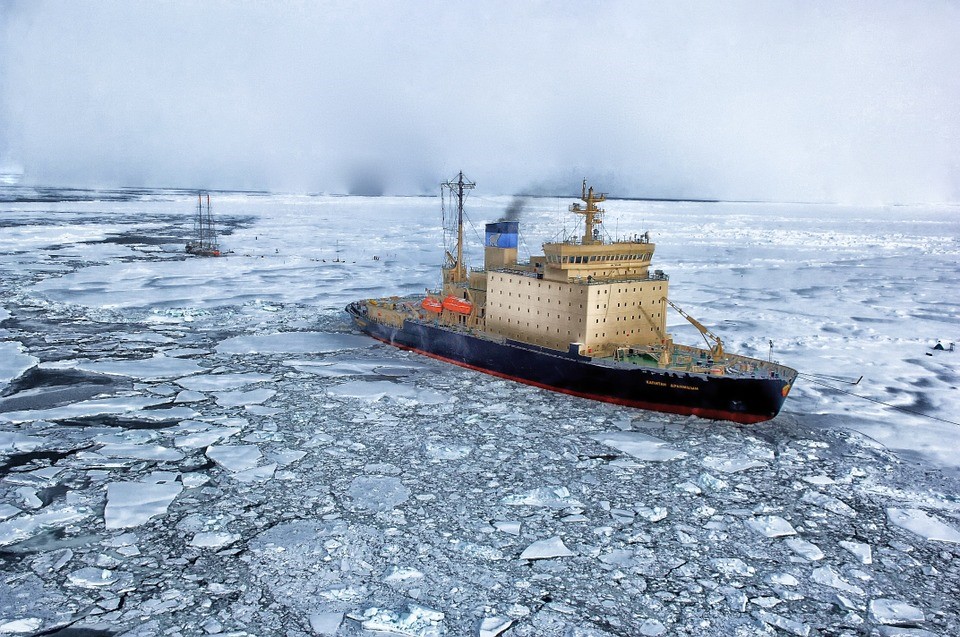The macro-Arctic geographic area is heating up politically this year with Russia announcing that it must meet two strategic goals to maintain its dominance over the northern region. The first is exploiting the overall region’s economic potential, according to Sergey Sukhankin of the Jamestown Foundation. He argues that Russia intends to accomplish this “through an intensification of exports of non-renewable energy resources and liquefied natural gas (LNG) in particular.” The second, just as concerning to Arctic Council states, is the development of a new Northern Sea Route. This evolving maritime transportation corridor is tangential to Russia’s coastline and will serve as a substitute for linking Asia to Europe in lieu of transiting the Suez Canal.
While the concept of a year-round, open water route across the northern Arctic is not new, it does point to Russia’s reorientation toward Asia and key to it emerging as a major trading and geopolitical partner with China in the coming years. With Russia struggling to win its war in Ukraine, increased sanctions by Western states, and general world condemnation of its human rights abuses, Putin may find China one of the few countries willing to conduct business with his country. After Moscow released the first strategy document labeled “On the Development of the Arctic Zone and Ensuring National Security Until 2035,” it appeared Putin would be able to implement his strategy, according to Sukhankin. In January 2022, he points out, Russia’s gas giant Novatek concluded a long-term deal with China’s ENN Natural Gas and Zhejiang Energy. It commits Moscow to supplying 1 million tons of LNG per annum to the Chinese market for the next 15 years. A year before Putin’s invasion of Ukraine, Novatek had signed another LNG contract with the Chinese Shenergy Group. Although it appeared Russian strategy was working, since the February invasion of Ukraine, the Arctic policy has stalled.
As the war drags into it fourth month, Putin is facing four major challenges to his ambitious Arctic policy. Western sanctions, which restrict its supply of the advanced technology components needed for LNG production. In its fifth round of sanctions the European Union barred EU producers from directly or indirectly supply Russia, unlike the 2014 rules which allowed the world’s largest industrial gas company German Linde, to supply Putin with critical production technologies. In particular, the current sanctions are a major obstacle to Putin’s strategic Arctic LNG2 mega-project. Sukhankin says that the single domestically supplied LNG project in Russia, is suffering from technical difficulties. Only states unfriendly to Russia have the large-scale liquefaction technology its needs to become a major play in the LNG marketplace. Prior to sanctions Russia purchased all the required technology from the US and Western Europe.
The second challenge facing Putin is how to encourage foreign investors not to pull out of Arctic-based energy projects like the 50-50 Gydan Energy joint venture that Gazprom Neft has with Shell. This project, originally planned as the center of an Arctic energy cluster, was scheduled to open in 2028. French Total Energies and the Japanese firm Mitsui and KOGMEC already announced their intention to withdraw, leaving Russia unable to carry out financial transactions related to the LNG2 mega project. As foreign investors lose interest in working with Russia, a newer player also appears ready to leave the scene. Last week, rumors inside China appear to confirm that three of its largest energy firms – Sinopec, China National Offshore Oil and China National Petroleum Corp, along with five other large Chinese engineering companies, all are stalling on future investments according to a May 23 story in the Moscow Times.
Decreased LNG production in the Arctic is the third challenge, as Putin is finding it more difficult to secure foreign funding. Domestically, large Russian banks, including Sber, Gazprombank, VEB.RF, and Otkrytie FC Bank, having come under sanctions. So far, Moscow has not found other funding for the mega-project. Sukhankin points to a fourth challenge – restricted Russian access to delivery methods. Reports indicate that the three largest shipbuilders in South Korea recently cancelled their $872 million contract to partner with Russian LNG producers to build large LNG ships to work in the Arctic. Although the loss of six ships is a huge blow to Russia, Sakhankin says there may be an even greater impact as Russia was in discussions to build an additional 15 ships with Korean-based Samsung Heavy Industries. If talks fail, which is likely, Russia’s Arctic strategy may fail. Although China and India may fill the gap, Russia’s grad Arctic strategy is facing serious blows since Putin’s invasion of Ukraine. Most nations appear willing to forego the economic benefits to try to force Putin to abandon his war in Ukraine. Putin is faced with two choices in the Arctic. It is highly likely that he will be forced to shut down his future plans. If not, he may emerge as a more dangerous adversary to the free world.
Daria Novak served in the U.S. State Dept.
Photo: Pixabay
